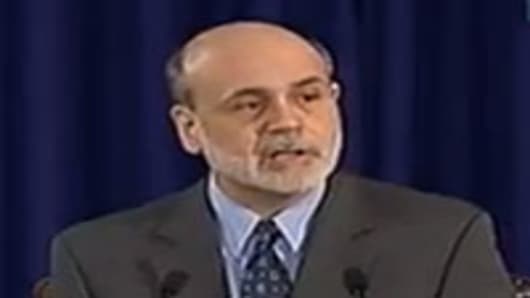The Federal Reserve’s forecast that rates could stay extremely low for another three years provides juice for risk assets like stocks, but signals more worries ahead for the economy.
The Fed also took the historic step of setting an inflation target of 2 percent, when it released its forecast. The Fed made news in two releases Wednesday, one its post FOMC statement at 12:30 p.m. and the other in its economic forecast at 2 p.m.
In its statement, the FOMC did not change its view on the economy, leaving some to guess the Fed sees more problems coming across the Atlantic as Europe struggles with its debt crisis.
“I think holding rates lower for longer is a reflection of the overall global growth profile, which includes the situation in Europe,” said Ian Lyngen, senior Treasury strategist at CRT Capital.
Lyngen said it appears the Fed is saying it won’t raise rates until 2015, since its statement said it was holding rates lowthrough 2014. Market expectations were for the Fed to raise rates in mid-2014.
The Fed’s statement altered language that had said the Fed will keep its now near zero rates extremely low through mid-2013. It now said “economic conditions—including low rates of resource utilization and a subdued outlook for inflation over the medium run—are likely to warrant exceptionally low levels for the federal funds rate at least through late 2014.”
With the economic projections released at 2 p.m., the Fed gave a snapshot of Fed members' views on when the Fed would first hike rates. In that, it trimmed its GDP forecasts for 2012 to 2104, and lowered its forecast for the unemployment rate to 8.2 to 8.5 percent in 2012.
The Fed now sees GDP growth between 2.2 percent and 2.7 percent for 2012, down from 2.5 to 2.9 percent, and 2013 growth of 2.8 to 3.2 percent, down from 3 percent to 3.5 percent.
Markets had expected the majority of views in the new charts to show the majority favored a 2014 time frame for the first hike. That came in as expected, with five FOMC members forecasting 2014 hikes.
But the surprise in the report was that three members thought rates could rise in 2012, and another three members, in 2013. The surprisingly hawkish views were balanced somewhat by forecasts from two members that rates would rise for the first time in 2016 and another for 2015.
Stocks rallied on the initial report, erasing a 54 point loss on the Dow before pushing into positive territory. The dollar sank, as the euro rose above 1.30. Buyers moved into the bond market, sending yields lower. Gold surged $50, closing above $1700 an ounce for the first time in six weeks, and oil added nearly a percent.
The 10-year yield fell to as low as 1.912 percent, from 2.02 percent before the midday release. After the 2 p.m. release, however, the yield was again rising, and was at 1.989 percent.
The Fed said it still sees the economy expanding moderately with improvement in employment, though unemployment is expected to decline only gradually.
“They remained a wet blanket,” said Miller, Tabak strategist Peter Boockvar. “No acknowledgement whatsoever to the improving data. I think they’re worried about growth. They have their foot on the pedal, down to the metal. I think they’re driving the wrong car, based on what’s going on. It’s good for stocks as far as lifting asset prices, but it does nothing for the actual economy.”
The Fed also kept in place "operation twist," a program under which it is increasing the average maturity of the securities in its portfolio by selling shorter duration Treasury securities and buying longer duration securities.
Fed Chairman Ben Bernanke, in his press briefing, acknowledged improvements in the economy but that the Fed is not ready to declare that the economy has entered a stronger phase. He also said the Fed would undertake further quantitative easing if necessary.
"There are some positive signs, no doubt. But at the same time we've had mixed results in other areas such as retail sales, and we continue to see headwinds emanating from Europe coming from the slowing global economy and some other factors as well," he said.
Deutsche Bank G-10 foreign exchange strategist Alan Ruskin said, in a note, that the Fed’s statement is a change more of its interest rate forecast than a material change in economic views.
“While the Fed’s characterization of the economy in the statement has not changed very much, the comment that conditions are likely to warrant exceptionally low levels for the funds rate ‘at least through late 2014’ is on the surface a major difference from the mid-2013 date given in the last statement,” wrote Ruskin.
“The question is did the Fed’s views on its own policy change that much? Almost certainly not. In reality the previous ‘mid-2013’ reference was probably low balling the date to take into account some of the skew attached to members who were thinking that rates might have to go up by mid-2013 or sooner,” he noted.
Follow Patti Domm on Twitter: @pattidomm



